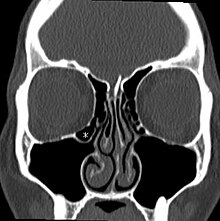Haller's cell

A Haller's cell is an additional ethmoid cell ( ethmoidal cell) that can be found in the orbital floor or in the roof of the maxillary sinus. It was first described by Albrecht von Haller , a Swiss anatomist. This is an anatomical standard variant that can be found in 5% to 30% of the population, depending on the literature. Haller's cells are usually found incidentally in a computed tomographic examination of the facial skull. In an unfavorable position, they could hinder the drainage of secretions from the neighboring maxillary sinus. Some studies suggest a greater Haller cysts with sinusitis (for an association sinusitis not), others. In any case, information about this anatomical variant is important when planning a surgical procedure in order to avoid complications.
Sources and individual references
- Mathias Cohnen: Head and Neck Radiology . Georg Thieme Verlag, 9 May 2012, ISBN 978-3-13-169491-1 , pp. 117–8.
- ↑ DM Yousem: Imaging of sinonasal inflammatory disease. In: Radiology. Volume 188, Number 2, August 1993, pp. 303-314, ISSN 0033-8419 . doi: 10.1148 / radiology.188.2.8327669 . PMID 8327669 . (Review).
- ↑ A. Tonai, S. Baba: Anatomic variations of the bone in sinonasal CT. In: Acta oto-laryngologica. Supplement. Volume 525, 1996, pp. 9-13, ISSN 0365-5237 . PMID 8908262 .
- ^ SA Stackpole, DR Edelstein: The anatomic relevance of the Haller cell in sinusitis. In: American journal of rhinology. Volume 11, Number 3, 1997 May-Jun, pp. 219-223, ISSN 1050-6586 . PMID 9209594 .
- ↑ M. Danese, B. Duvoisin et al. a .: [Influence of naso-sinusal anatomic variants on recurrent, persistent or chronic sinusitis. X-ray computed tomographic evaluation in 112 patients]. In: Journal de radiologie. Volume 78, Number 9, September 1997, pp. 651-657, ISSN 0221-0363 . PMID 9537184 . (Review)
- ↑ HJ Kim, M. Jung Cho a. a .: The relationship between anatomic variations of paranasal sinuses and chronic sinusitis in children. In: Acta oto-laryngologica. Volume 126, Number 10, October 2006, pp. 1067-1072, ISSN 0001-6489 . doi: 10.1080 / 00016480600606681 . PMID 16923712 .